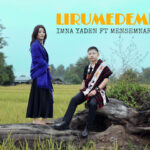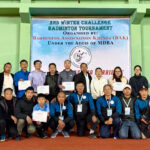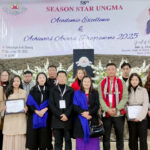Returning ‘Folk’ to Lore: Towards Vernacularised Storytelling in English

Reading Tales from the Enchanted Village is like being drawn into an unfamiliar rhythm—a pulse that both captivates and unsettles. This collection of folktales, drawn from the author’s native village of Zhavame, refuses to conform to the familiar narrative structures many readers have been taught to expect. The stories are filled with twists and moments where what seems straightforward turns inward, leaving the reader disoriented and reflective.
Disorientation, in this case, is not accidental; it is intentional. The author’s choice to adhere to the narrative logic of native tellers, rather than adapting these tales into a more “universal” form, feels deliberate and political. As one makes her way through this book, the undercurrent of the writer’s vernacular Poula, along with its narrative logic undulates beneath the flow of English words, creating a sense of listening to the stories in polyphonic registers. This approach invites readers to confront the limits of their own expectations, requiring a certain openness to strangeness and discomfort.
For those familiar with Vladimir Propp’s morphology of Russian folktales, the structure of Tales from the Enchanted Village might initially appear recognizable. Propp’s analysis suggests predictable plot functions: a hero departs, faces challenges, overcomes them, and returns transformed with a moral lesson. A format sponsored by the publishing industry that has made a tradition of moderating originally explicit, lurid and violent folktale content to suit general and more often, younger consumers. The fairytales of the Brothers Grimm, that we now unquestioningly consider ‘children’s’ stories were originally rather grim. The folktales of Zhavame complicate this mainstream association of folktales with a kind of infantilized, censored childhood with narrative re-sequencing that leaves readers both delighted and unsettled.
One striking element of these tales is the presence of two conclusions—two “morals of the story.” The first is often familiar, satisfying the need for closure and the conventional happy ending. For example, in the story of Zhopozholi and his wife, Rone, they live happily ever after with two friends. Yet, just as the reader settles into this resolution, a second, dissonant moral appears: Zhopozholi’s parents die of starvation. This second conclusion arrives abruptly, often unrelated to the main plot, forcing the reader to re-evaluate the entire tale. Similarly, in another story about two orphaned brothers who thrive after obeying a forest creature, the conclusion is followed by the bizarre note that they grew so fat their navels leaked, causing their deaths. This disorienting twist compels us to reconsider the meaning of the story.
For Naga writers, writing in English often means translating while grappling with a language that vies for space with and threatens to displace our vernacular tongues. Much has been written on how language shapes thought—how words, sentence structure, and narrative form guide our perception of the world. Language, in a way, creates our reality. Through language, we reorient our understanding of the world. For Naga writers in English, the choice to let our vernaculars undergird our English writing becomes a form of challenging – ourselves and our readers, how we have been taught to think and know.
In Tales from the Enchanted Village, the second moral is not merely a quirky cultural addition but a disruption, a resistance to neat Proppian logic. It refuses closure or the simplicity of “lesson learned.” By doing so, it forces readers to sit with the discomfort of ambiguity. The second conclusion, often accompanied by tangential asides and carnivalesque elements, twists the story’s innards- the way we do when we clean intestines for eating, exposing its contradictions and unresolved tensions. The folktale is turned inside out, revealing its guts—messy, disconcerting, and resistant to easy interpretation.
What makes Tales from the Enchanted Village so refreshing is precisely this refusal to conform. The author is not interested in making these folktales “universal” by smoothing over their strangeness. Instead, she emphasizes their difference, refusing to fit them into mainstream narrative expectations. An effort more significant because she is also a publisher – currently, our state’s most prominent and prolific one. Her efforts to challenge the dominant political economy of publishing and to dismantle established paradigms of taste enforced by the world literary market has been notable. As text and metatext, therefore, Krocha’s book is not merely a stylistic choice but a decolonial one. By presenting these stories in their full complexity, the author resists the colonial impulse to domesticate or make them comfortable.
This book is not just a collection of folktales; it is an invitation to rethink how we read, listen, and understand. It calls us to embrace disorientation as a necessary part of the reading experience. And while I will not delve into how perfectly Krusielhou Tepa’s dystopian painting mirrors the themes in this book—that deserves another essay—the disorientation in these tales reminds us that the world is filled with ways of knowing that do not always align with our own.
This collection offers a glimpse into the communal imagination of Zhavame—a time and space that feels almost mythical, where animals, humans, and spirits existed in a vital yet wary awareness of one another. This is not the romanticized coexistence often depicted in conventional narratives of nature, but one marked by mutual respect, born out of recognizing interdependence and shared influence. In these stories, the boundaries between the human and non-human world are porous and ever-shifting. The folktales speak of a time when beings did not live in isolation, and the actions of one affected the survival and well-being of others. Animals are not mere symbols; they are agents with their own knowledge and desires. Spirits are not simply supernatural forces to be feared but are woven into daily life, part of the ecology of existence. Tales from the Enchanted Village reminds us that rigid separations between human and non-human, living and non-living, are not the only way of being.
The “folk” of Zhavame offer a critical (re-)vision of co-dependency, recognizing that all beings are entangled, shaping one another. These tales challenge us to rethink our relationships with the world, acknowledging our dependence on forces we may not fully understand. The story of one being is always part of a larger, interconnected narrative. Sara Ahmed’s concept of “affect economies” comes to mind—the idea that emotions circulate between bodies, objects, and spaces, shaping how we relate to each other. In Tales from the Enchanted Village, this relationality is central to the stories. A relationality we would do well to embrace again, as the natural world around us falls apart and wreaks havoc because our sordid affair with neoliberal development has estranged us to our native world.
The tales also speak to a past without borders, a theme that resonates with contemporary concerns about the violence of nation-states, of states within nations and the arbitrariness of borders that manifest intimately and insidiously in the lived experience of Nagas. Zhavame, a village caught in political liminality due to shifting boundaries, offers lessons about the fluidity of space and belonging. The folktales recall a time when borders between people and worlds were not fixed, and movement across spaces was not restricted by the rigid divisions we now take for granted.
These tales invite us to reflect on living in liminal spaces, where identities and boundaries are in constant flux. Victor Turner’s concept of liminality—an in-between state that allows for transformation—is suitable here. He suggests that liminality disrupts social order, enabling new ways of being. Tales from the Enchanted Village features what Turner calls, ‘threshold people’—like the daughter of Tipumuvu (King of the stars) who marries the orphan Muranatu, or orphan Shoposho who befriends the tiger Paokhadu. For these liminal characters, living in-between worlds is not temporary but a way of life. And this way of life becomes a mirror to a liminality we all experience in some way of the other as people in a post-globalized world. The villagers of Zhavame, both past and present, like the rest of us, live in constant negotiation between self and other, known and unknown.
This condition of living in liminality is deeply political. As borders harden and nationalisms rise, Krocha offers a vision of belonging that rejects the logic of borders and fixed identities. The stories remind us that borders are constructs, and as such, they can be undone. Zhavame’s folktales, with their fluidity and refusal of closure, offer a radical reimagining of belonging. In these tales, we find storytelling that speaks to both past and present, refusing to be constrained by linear notions of time or space. The world of Zhavame is one of entanglements, where the boundaries between beings and worlds constantly shift. Tales from the Enchanted Village presents a model for resisting the pressures of borders and teaches us how to live with and through our entanglements, rather than in spite of them.
As fellow writers might agree, artistic creation often emerges from a sense of being out of place or disoriented. In Tales from the Enchanted Village, this disorientation is a gift, asking us to reconsider the stories we have been told about boundaries and belonging. By foregrounding vernacular, plebian and even subaltern ways of telling, Krocha returns the voice of the people, the ‘folk’ to lore in written form. In doing so, her folktales open up new possibilities for how we might live together in this and other alternative worlds.



